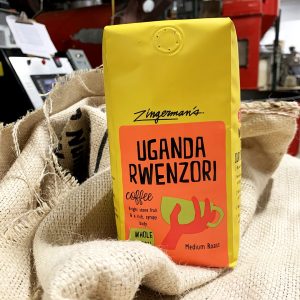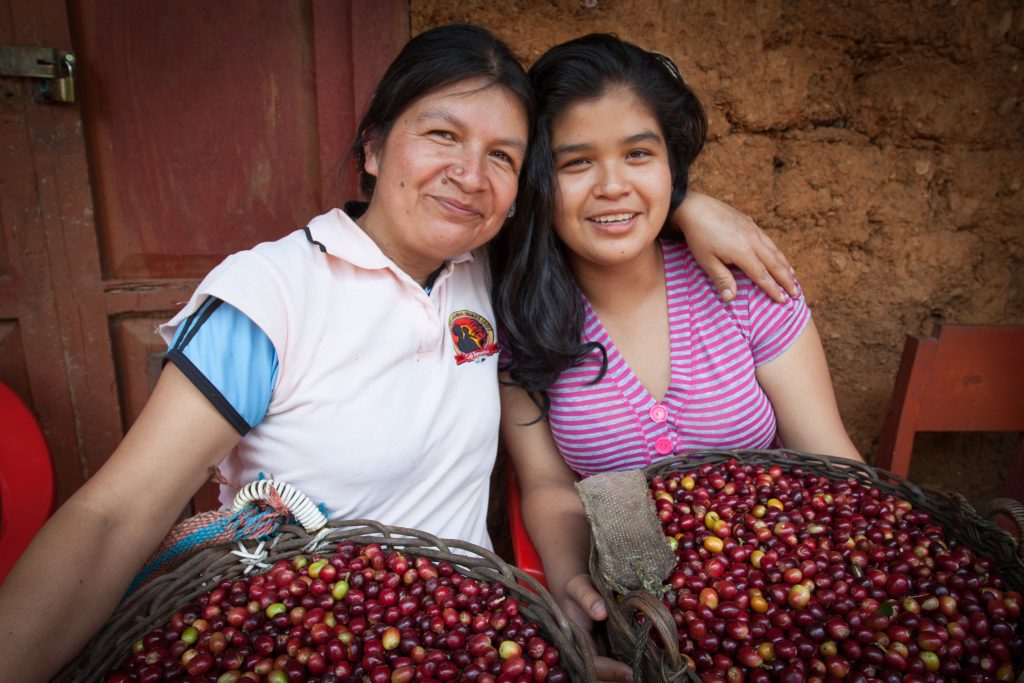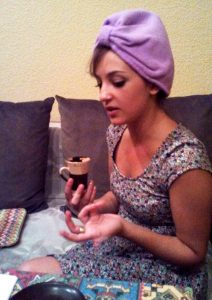Uganda Rwenzori Coffee
New Coffee of the Month from East Africa
Ari Weinzweig, CEO & Co-Founder of Zingerman’s
| While so much has been turned topsy turvy over the last year, one thing that has provided comfort and consistency throughout has been the quality of the beans at the Coffee Company. In fact, I would venture to say, through all the ups and down of the last twelve months, the coffee has actually gotten better. The April Coffee of the Month—from the mountains of southwest Uganda—is pretty darned amazing. Coffee originates to the north of Uganda in Ethiopia—it’s grown wild there for far longer than humans have been consuming it. Coffee is a relatively recent arrival in Uganda, essentially part of the same Industrial Age push to identify export crops that brought coffee to Central and South America. Today Uganda produces about 4% of the world’s coffee, tiny by the standards of say Brazil, but about four times where it was in the early years of the 20th century. |

The Rwenzori mountains where these beans are grown are near the country’s western border with the Democratic Republic of the Congo, and to the north of the Rwandan frontier. You’ll see the mountains on the map about halfway between Lake Stanley and Lake Edward, to the west of Lake Victoria (Africa’s largest lake). The mountains range up to 16,000 feet, and the coffee is grown in the lower (but still high) altitudes in the shade of banana trees, which protect the delicate coffee cherries from “burning” in the sun. The coffee is a “natural process”—dried in the sun—which concentrates the sweetness and the flavor in a way that I love.
Steve Mangigian, long time managing partner at the Coffee Company, says, “We immediately loved the fruitiness of this coffee. That’s what caught my attention. It exemplifies the characteristics of great East African coffee.” Juicy peach notes (speaking of which, the Peach Truck is coming to town this summer), maybe you could say even a bit of nectarine. It’s nicely chocolatey and terrifically tasty. It’s very good straight out of the Fetco pots at the Coffee Company, Roadhouse, and Deli. If you’re at the Coffee Company it is particularly chocolatey in a pourover and delicately delicious brewed in a syphon pot. Add a piece of the Bakehouse’s marvelous Mandelbread or a Big O Oatmeal Raisin cookie and bring a bit of beauty to your day!
Excerpt from Ari’s weekly Top 5 E-Newsletter. To stay in-the-know about things that Ari is excited about in the Zingerman’s family, sign up here!
Erlita’s Lot Coffee from Peru
Grown, harvested, sold, and shipped by women
Ari Weinzweig, CEO & Co-Founder of Zingerman’s
Back in 2004, Isabel Uriarte Latorre co-founded Café Femenino, an organization dedicated to empowering women on the front lines of the coffee industry. From the get-go, she built the business to support women in the work world financially, spiritually and socially. The project allows women to produce high-quality coffee and get paid commensurately—they’re not stuck bargaining with aggressive buying agents out on the marketplace. And, as per what I wrote above, to boost the energy of women who had generally been left out, ignored, or even abused, and help them reclaim the full lives to which they have always been entitled. The folks at Café Femenino share that:
“Women in remote and rural coffee communities face a host of challenges that keep them trapped in poverty. Many of these isolated women live in male-dominated societies and have very little financial control or decision-making power. 464 women farmers in northern Peru decided to change this dynamic by separating their coffee production from the men’s. In that moment, for the first time, this group of women created their own product and income… to support social justice and empowerment for women coffee producers worldwide.”

Coffee production came to Peru in the 1700s. After two centuries, the heirloom typica variety still comprises 60 percent of the country’s exports. There are more than 110,000 coffee growers in Peru, most of whom are indigenous to these landscapes and speak Spanish only as a second language. The average land-holding farmer lives on less than three hectares, hours from the comforts of electricity and running water. Erlita Baca Arce’s farm is near the Peruvian village of Nueva York, a small coffee community in the Amazonas region of northern Peru, east of the Andes Mountains, at 5700 to 6500 feet above sea level—an ideal altitude for high-quality Arabica coffee trees. Erlita has been part of the project since its inception and now serves as the treasurer of the coop, and as she explains:
“Café Femenino has given me many opportunities to improve the quality of my coffee and the quality of life for my family. I invest the premium I earn in improving our community, providing education for our daughters, and improving the food that we feed our families. Café Femenino has been wonderful in improving the self-esteem and empowerment of the women in our community.“
Erlita is not alone in her positive comments. Every article I’ve read about Café Femenino details outstanding results: increased local recognition of the work the women are doing, both in the fields and on the home front; a reduction in abuse (physical, emotional, and sexual); an increase in income; more men are participating in child care and housework; and upswing in school attendance among local girls. In addition, because the female coffee producers in the area now have the potential to get a better price for their coffee, many men are signing the deeds of their land over to their wives so their coffee will be eligible for Café Femenino designation.
While dignity, meaningful work, and good coffee are always in season, National Women’s History Month is a particularly good time to take notice of Erlita’s Lot. The history of the event goes back over a century to the years before WWI and the Spanish flu, to the end of February 1909, when “National Women’s Day” was sponsored by the Socialist Party of America. By March of 1911, International Women’s Day (IWD) was marked by over a million people demanding the right to vote for women, workplace safety, equitable pay, etc. Six years later, on March 8, 1917 in the Russian capital of Petrograd, women workers took to the streets for National Women’s Day, demonstrating en masse in an event that unexpectedly turned into the Russian Revolution. The Tsar abdicated a week later, on March 15. Leon Trotsky wrote, “March 8th was International Women’s Day, and meetings and actions were foreseen. But we did not imagine that this ‘Women’s Day’ would inaugurate the revolution.”
The Erlita’s Lot coffee is as great as the story behind it. Smooth, a bit of dark chocolate, maybe even like a piece of toasted Country Miche bread from the Bakehouse. The coffee has a surprisingly clean finish and modestly full mouthfeel. All the brew methods have been good, but I’m stuck on the smoothest flavor of the bunch, which I found to be Chemex (the syphon pot and the Clever brewing weren’t far behind). Sip some of this great new coffee and nibble on a Bakehouse oatmeal raisin cookie. Erlita’s Lot is available at the Coffee Company, Next Door at the Deli, and at the Roadhouse. Sit, and appreciate the morning as we move into spring. And because I seem to have a proclivity of late for Peruvian poets, here’s a short one that seems right for the moment from surrealist writer Blanca Varela:
it’s seven in the morning
it’s the perfect time to start
dreaming
the coffee becomes eternal
and the sun eternal
if you don’t move
Excerpt from Ari’s weekly Top 5 E-Newsletter. To stay in-the-know about things that Ari is excited about in the Zingerman’s family, sign up here!
Coffee’s Sixth Sense 🔮
A History of Fortune Telling and Family Tradition
By Michelle Abbey, Zingerman’s Coffee Company
The year is 1974. The setting is one startlingly bygone, culturally: a family living room, thick with cigarette smoke. Zingerman’s Coffee Company’s Managing Partner, Steve Mangigian, is 10 years old. After a meal together, Armenian coffee is not only served, but read. Steve recalls the female elders of his family flipping the contents of their cups onto saucers, scouring the grounds for images and their associated fortunes to emerge.
This is the story Steve consistently tells on his tours, during our “What is your first memory of coffee?” group icebreaker. “My parents needed a pot of Folgers to wake up.” is a common answer – I have yet to hear a guest share Steve’s experiences with family divination. He lights up; it’s a beloved childhood memory.
His experience while treasured is not unique. In fact, Steve isn’t the sole Armenian here in the small family of Zingerman’s Coffee Company! We’ve had a handful of Armenians come and go, and our Purchasing Manager, Laura, has Armenian roots.
“…She said it was extremely creepy and really hated the whole thing!”
The tradition in her family is remembered differently: “My mom talked about the tea leaf readings when she was a kid. This would have been the 1930’s. She remembers all the old Armenian ladies sitting in a circle bending over these cups and telling fortunes – they would tip them over into the saucers and read the leaves. She said it was extremely creepy and really hated the whole thing!”
The practice Steve and Laura describe in their families is called Tasseography: a divination or fortune-telling method that interprets patterns in tea leaves, coffee grounds, or wine sediments. The terms derive from the French word tasse (cup), which in turn derives from the Arabic loan-word into French tassa, and the Greek suffixes -graph (writing), -logy (study of), and -mancy (divination).
The practices’ origins can be traced back to medieval Europe. Fortune tellers read molten substances such as wax or lead. The method evolved into reading patterns of tea leaves after Dutch merchants introduced tea to Europe via trade routes to China. The tradition of coffee cup reading specifically is believed to have started in the 16th century when coffee made its way to the Ottoman Empire and the Middle East. The cultivation and distribution of coffee started in Ethiopia and moved from Yemen to the Arab trade and then to the Ottoman Empire. Armenians then popularized coffee in Europe.
Turkish coffee reading is very popular in Turkey and Greece. You can also find it in Russia and Eastern Europe, as well as Baltic and Middle Eastern countries.

A traditional Ibric (kettle) and Armenian coffee cups. Note how the sides of the coffee cup do not slope down – this is necessary for proper grounds reading.
This tradition has gone by the wayside for some families, but the Mangigians are keeping it alive in their brood. Steve’s daughter, Bethanie, has taken over the tradition – but took her own route to get there.
“I actually wasn’t introduced to Armenian fortune-telling within my family, I wasn’t around it a lot as a kid.
“‘…’I see three men in your cup, encircling you.’ It was dead on, I had three orbiting at that time!”
I started doing this when I lived in New York. I was in college and took a course in Armenian history. I was first captivated by cup reading sitting in an ancient Armenian library. My professor did my first reading for me, it was startling and thrilling. She said, ‘I see three men in your cup, encircling you.’ It was dead on, I had three orbiting at that time! Should we include that?” she laughs.
Bethanie studied and lived abroad in the familial homeland of Armenia, with a host family. She got practice pulling cups with them, a family of artists.
“In their home and in the country itself, I was surrounded by beautiful imagery and architecture. There were beautiful symbols everywhere to inspire interpretations.”
It’s not just the cultural connection and experiences which draws Bethanie to cup reading.
“My mom uses the word ‘Kezba’, to describe this sixth sense that we have. And I work closely with people as a social worker and therapist. When you read cups, you have a connection with that person. I love this medium as a way to develop relationships with people. You cut through small talk to who they are, what their journey is. I can guide the reading, but people come up with their own interpretations, which is fascinating insight.”
Her eeriest experience?
“I did a cup reading at a party for a guy I had met just a week prior. We ended up dating later on, and the symbols I saw in his reading ALL appeared throughout our relationship. A chameleon was one symbol – it ended up being way too telling! This is why I prefer to read for strangers. Reading for friends can hit too close to home. You have to be prepared for what the cup says.”

Bethanie hosts an Armenian Christmas party every year on January 6th, at her home in New Orleans. Her party favor giveaway is a drawing for someone to get a cup reading.
How do you read coffee, anyway? Simply drink your Armenian-style coffee in white china with no inside pattern or decoration. Shapes and patterns inside the coffee cup and on the saucer need to be visible for reading. After drinking most of the liquid in the coffee, cover the cup with the upside-down saucer and swirl three times. You wait for the grounds to fall from the bottom of the cup. This is why it is important to use the Armenian style espresso cup which is not rounded on the sides. The grounds fall down the sides of the espresso cup and dry at the bottom.
Put it down and allow a few minutes for the coffee to settle. Though it has some universally agreed rules, coffee cup reading is a very personal experience based upon on the “sixth sense”.
The type of coffee you use doesn’t really matter, just make sure it’s ground even finer than espresso and prepared, well, however your grandmother taught you to!
STEVE’S RECIPE:
- 8g coffee (Grind setting: 1 – finer than espresso, should feel like powder)
- 80g cold water
- 6g sugar
- 1 pinch of fresh ground cardamom OR
- 1 drop of rosewater
DIRECTIONS:
- Combine ingredients
- Bring to a boil and immediately
- Remove from heat
- Pour slowly to minimize the quantity of grounds in cup
Bethanie says this practice feels more precious in these times. “There’s a war against this small country [Armenia]. Holding onto these traditions feels even more important now. There are a lot of people I’m thinking about and worried about there right now.
“You may lose territory, but you can hang onto your culture.”
She wishes she could have been at the table with her Dad when her great aunt was telling fortunes. “It goes to show that these things need to be explicitly passed on, or you may lose them. You may lose territory, but you can hang onto your culture.”
Check out tasseography symbolism and best practices:
- https://coffeecupreadingsonline.com/divine-meanings-of-coffee-shapes/
- http://www.turkishstylegroundcoffee.com/turkish-coffee-reading/
—-
SOURCES:
- https://en.wikipedia.org/wiki/Tasseography
- https://coffeecupreadingsonline.com/divine-meanings-of-coffee-shapes/
- http://asbarez.com/174421/the-art-of-coffee-cup-reading-lives-on-through-a-new-generation/
- http://folklore.usc.edu/armenian-coffee-readings-ritual/
- http://www.digitaljournal.com/blog/16194
- http://elegantserenity.com/tasseography-art-tea-leaf-reading-future/
- http://www.turkishstylegroundcoffee.com/turkish-coffee-reading/


